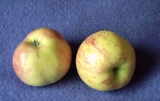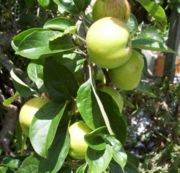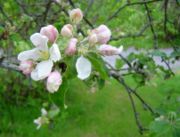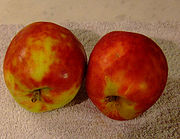
Gravenstein
Encyclopedia

Apple
The apple is the pomaceous fruit of the apple tree, species Malus domestica in the rose family . It is one of the most widely cultivated tree fruits, and the most widely known of the many members of genus Malus that are used by humans. Apple grow on small, deciduous trees that blossom in the spring...
native to Gråsten
Gråsten
Gråsten , stress on last syllable) is a town with a population of 4,200 on the east coast of the Jutland peninsula in south Denmark by the Nybøl Nor at an inlet of the Flensburg Fjord. It belongs to the Sønderborg municipality in Region of Southern Denmark...
in South Jutland, Denmark
Denmark
Denmark is a Scandinavian country in Northern Europe. The countries of Denmark and Greenland, as well as the Faroe Islands, constitute the Kingdom of Denmark . It is the southernmost of the Nordic countries, southwest of Sweden and south of Norway, and bordered to the south by Germany. Denmark...
. The variety was discovered in 1669 as a chance seedling
Chance seedling
A chance seedling is a plant that is the product of unintentional breeding. It may be a genetically unique individual with desirable characteristics that is then intentionally bred. Plants that come from the artificial union of gametes from a maternal and paternal source are not chance...
, although there is some evidence that the variety originated in Italy and traveled north.
Description and growing conditions

Cider
Cider or cyder is a fermented alcoholic beverage made from apple juice. Cider varies in alcohol content from 2% abv to 8.5% abv or more in traditional English ciders. In some regions, such as Germany and America, cider may be termed "apple wine"...
. It does not keep well, so it is available only in season. In addition, their short stems and variable ripening times make harvesting and selling difficult.
The skin is a delicately waxy yellow-green with crimson spots and reddish lines, but the apple may also occur in a classically red variation.

Areas of production
In AustriaAustria
Austria , officially the Republic of Austria , is a landlocked country of roughly 8.4 million people in Central Europe. It is bordered by the Czech Republic and Germany to the north, Slovakia and Hungary to the east, Slovenia and Italy to the south, and Switzerland and Liechtenstein to the...
, Gravensteins are used for the production of high-quality brandy (Obstler) that is particularly popular in the southern Steiermark).
In Denmark
Denmark
Denmark is a Scandinavian country in Northern Europe. The countries of Denmark and Greenland, as well as the Faroe Islands, constitute the Kingdom of Denmark . It is the southernmost of the Nordic countries, southwest of Sweden and south of Norway, and bordered to the south by Germany. Denmark...
Food Minister Hans Christian Schmidt
Hans Christian Schmidt
Hans Christian Schmidt is a danish politician and has been the Minister for transportation. A teacher by profession, he was the Danish Minister of Food from 2004 to 2007. Before that, he was the Minister for the Environment from 2001...
proclaimed the Gravenstein to be the "national apple" on 18 September 2005, although its market share has since decreased in relation to imported apples.
In the United States
United States
The United States of America is a federal constitutional republic comprising fifty states and a federal district...
, they are found most widely on the west coast, and in particular, around the Sonoma County, California
Sonoma County, California
Sonoma County, located on the northern coast of the U.S. state of California, is the largest and northernmost of the nine San Francisco Bay Area counties. Its population at the 2010 census was 483,878. Its largest city and county seat is Santa Rosa....
, town of Sebastopol
Sebastopol, California
Sebastopol is a city in Sonoma County, California, United States, approximately north of San Francisco. The population was 7,379 at the 2010 census, but its businesses also serve surrounding rural portions of Sonoma County, totaling about 50,000 people...
. Luther Burbank
Luther Burbank
Luther Burbank was an American botanist, horticulturist and a pioneer in agricultural science.He developed more than 800 strains and varieties of plants over his 54-year career. Burbank's varied creations included fruits, flowers, grains, grasses, and vegetables...
praised the apple, "It has often been said that if the Gravenstein could be had throughout the year, no other apple need be grown."
In Canada
Canada
Canada is a North American country consisting of ten provinces and three territories. Located in the northern part of the continent, it extends from the Atlantic Ocean in the east to the Pacific Ocean in the west, and northward into the Arctic Ocean...
it is widely grown on both coasts, although more in old farmstead orchards and backyards than in commercial orchards.
During the first half of the 20th century, Gravensteins were the major variety of apples grown in western Sonoma County
Sonoma County, California
Sonoma County, located on the northern coast of the U.S. state of California, is the largest and northernmost of the nine San Francisco Bay Area counties. Its population at the 2010 census was 483,878. Its largest city and county seat is Santa Rosa....
, and were the source for apple sauce and dried apples
Dried fruit
Dried fruit is fruit where the majority of the original water content has been removed either naturally, through sun drying, or through the use of specialized dryers or dehydrators. Dried fruit has a long tradition of use dating back to the fourth millennium BC in Mesopotamia, and is prized...
for the U.S. troops in World War II
World War II
World War II, or the Second World War , was a global conflict lasting from 1939 to 1945, involving most of the world's nations—including all of the great powers—eventually forming two opposing military alliances: the Allies and the Axis...
. Most of the orchards in Sonoma County are now gone due to a combination of suburban development
Urban sprawl
Urban sprawl, also known as suburban sprawl, is a multifaceted concept, which includes the spreading outwards of a city and its suburbs to its outskirts to low-density and auto-dependent development on rural land, high segregation of uses Urban sprawl, also known as suburban sprawl, is a...
, a shift to wine
Wine
Wine is an alcoholic beverage, made of fermented fruit juice, usually from grapes. The natural chemical balance of grapes lets them ferment without the addition of sugars, acids, enzymes, or other nutrients. Grape wine is produced by fermenting crushed grapes using various types of yeast. Yeast...
production, and economic changes in the apple industry. Only six commercial growers and one commercial processor remain in Sonoma County as of 2006. In 2005, Slow Food USA declared the Gravenstein apple a heritage food and included it in their Ark of taste
Ark of Taste
The Ark of Taste is an international catalogue of heritage foods in danger of extinction which is maintained by the global Slow Food movement. The Ark is designed to preserve at-risk foods that are sustainably produced, unique in taste, and part of a distinct ecoregion...
. Slow Food USA reports that production in Sonoma County is currently 750,000 boxes (15,000 tons) of Gravensteins a year; a third of the fruit (250,000 boxes) is of premium market quality.
They are not a production apple in New Zealand
New Zealand
New Zealand is an island country in the south-western Pacific Ocean comprising two main landmasses and numerous smaller islands. The country is situated some east of Australia across the Tasman Sea, and roughly south of the Pacific island nations of New Caledonia, Fiji, and Tonga...
and are not available in grocery stores anywhere in the country. There are a few trees here and there though and on occasion, a small fruit grower will either have them for sale or allow a u-pick. On the North Island of New Zealand
New Zealand
New Zealand is an island country in the south-western Pacific Ocean comprising two main landmasses and numerous smaller islands. The country is situated some east of Australia across the Tasman Sea, and roughly south of the Pacific island nations of New Caledonia, Fiji, and Tonga...
, they are ready for picking around the last week of February to the first week of March.
History
The Gravenstein was introduced to western North AmericaNorth America
North America is a continent wholly within the Northern Hemisphere and almost wholly within the Western Hemisphere. It is also considered a northern subcontinent of the Americas...
in the early 19th century, perhaps by Russian fur traders
Fur trade
The fur trade is a worldwide industry dealing in the acquisition and sale of animal fur. Since the establishment of world market for in the early modern period furs of boreal, polar and cold temperate mammalian animals have been the most valued...
, who are said to have planted a tree at Fort Ross in 1811. The Gravenstein apple was introduced to the Canadian province of Nova Scotia in the 19th century. Charles Ramage Prescott
Charles Ramage Prescott
Charles Ramage Prescott was a merchant, noted horticulturalist and political figure in Nova Scotia. He represented the town of Cornwallis in the Nova Scotia House of Assembly from 1818 to 1820....
, the father of the Nova Scotian apple industry, grew Nova Scotia's first Gravensteins in his orchard at Acacia Grove. By 1859, Gravenstein trees were commonly cultivated on Nova Scotian farms. The Gravenstein apple is still considered the choicest apple by many Nova Scotians.
External links
- Slow Food USA
- http://www.gravensteinapplefair.com Gravenstein Apple Fair, Sebastopol, CA

